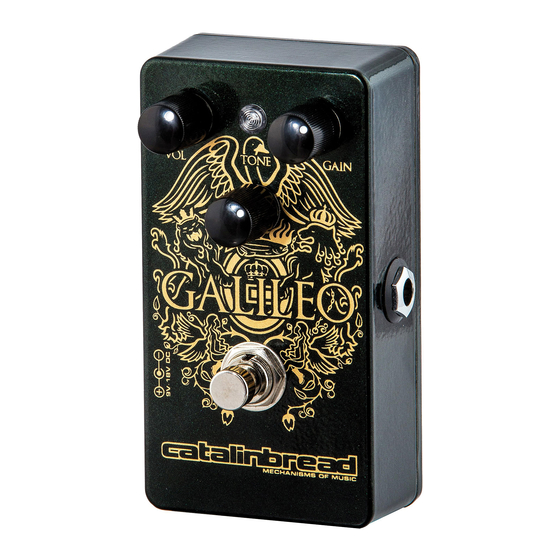
Advertisement
Table of Contents
GALILEO MANUAL
Despite being one of the world's most celebrated guitarists, Brian May keeps his rig relatively
uncluttered and has done so for decades. Fans, players and collectors have been chasing
authentic May tone for just as long. And unlike many artists that have relied on piles of guitars,
pedals and amps across several eras, May's enduring tone comes down to just a few
components. Despite achieving a wild array of tones across 15 albums, May's tone boils down
to his home-made Red Special guitar, a monolithic wall of Vox AC30s and a treble booster. The
treble booster circuit is always on, while May cycles through the array of switches and knobs on
his guitar to achieve his multifaceted sound. With our Galileo, we've distilled this tone into a
solitary stompbox, while still leaving the door open to achieve loads of tones with just your guitar
and fingers. Let's dive in!
CONTROLS
Gain: Just like a real AC30, this controls the amount of distortion present in the signal, from the
light-breakup "jangly" sound for which clean AC30 is known, to blistering leads when cranked.
This control is highly interactive with your guitar's knobs and any outboard guitar-mounted
switching you may have.
Tone: While AC30s offer up treble and bass controls, May never cared for the bass side much.
This Tone control governs the amount of treble present in the signal, very useful for brightening
up a dark amp or post-Galileo drive pedal. The Galileo's Tone knob also goes way beyond the
boundaries of a normal AC30 for a different flavor of Vox that leaps out of any mix.
Volume: Turn it up, volume goes up.
QUICK START GUIDE
The topological signal flow is thus:
[Treble Booster] → Gain → Tone → Volume
The treble booster circuit is always in the signal path and is pre-set; it cannot be adjusted. Hey,
that's Brian May! This circuit is in itself highly susceptible to even slight changes in guitar
controls, and feeds the Vox circuit in series. Like most amps, Gain/Tone/Volume is the standard
order of appearance. Running the Gain at zero still gives you a full dose of treble booster, so the
inherent janglyness of the AC30 is at its peak on this setting. Keep in mind that the treble
booster circuit is always on and so your playing dynamics should adjust to compensate to this.
With that said, it's important to know how your amp sounds by itself before considering the
Galileo's placement. This will help you understand how the frequency response of your amp and
the Galileo will interact.
If the Galileo is your only pedal or you're running it right before your amp: Certain mid-
scooped amps will accentuate the already trebly content of the Galileo and the result may be
less than pleasing. You may wish to EQ the amp a little darker than usual in order for the treble
Advertisement
Table of Contents

Summary of Contents for Catalinbread GALILEO
- Page 1 This Tone control governs the amount of treble present in the signal, very useful for brightening up a dark amp or post-Galileo drive pedal. The Galileo’s Tone knob also goes way beyond the boundaries of a normal AC30 for a different flavor of Vox that leaps out of any mix.
- Page 2 Adjust the pedal after the Galileo to account for some extra treble and get to work. Upon plugging the Galileo in for the first time, set the Tone control a hair above zero, turn Gain all the way down. Inch the Gain up until you find a spot you like, then adjust Tone to infuse a little treble back in.















Need help?
Do you have a question about the GALILEO and is the answer not in the manual?
Questions and answers